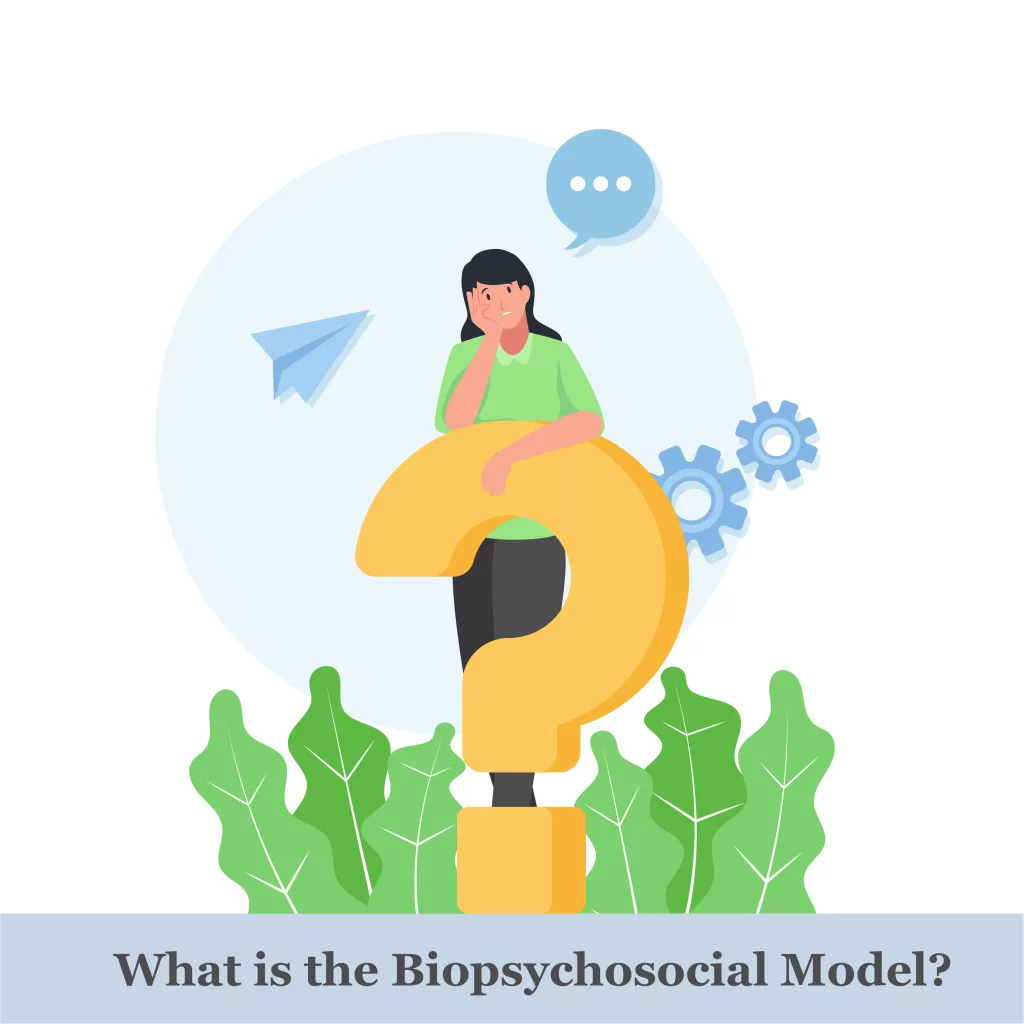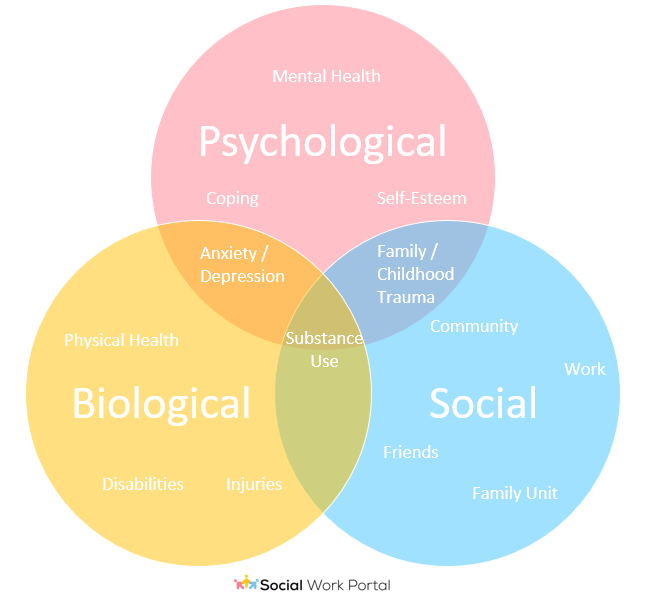2024 Guide on Biopsychosocial Approach & Biopsychosocial Model in Psychology
Everything You Need to Know About Biopsychosocial Theory and Biopsychosocial Model of Health
Did you know that according to the World Health Organization, mental illness affects one in four people globally?
While there has been much progress in understanding and treating mental illness, there is still much that we don’t know. This is where the biopsychosocial model and biopsychosocial approach come in.
In this Social Work Portal job aid, we’ll go over everything you need to know about biopsychosocial model of health including biopsychosocial meaning, biopsychosocial theory, biopsychosocial factors, and biopsychosocial spiritual model.

Biopsychosocial Model of Health – Biopsychosocial Meaning
Buckle up and get ready to get a good understanding of biopsychosocial meaning and get an answer to the question: “What is the biopsychosocial model?”
Would you like to share feedback on the bio psycho social model? Is there any biopsychosocial model PDF or biopsychosocial assessment template social work PDF that has provided great value to you that we can include in this guide for other mental health professionals to leverage? If so, contact the Social Work Portal Team.

See Also: Psychosocial Assessment Examples for Social Workers
Table of Contents: What is the Biopsychosocial Model?
Keep on scrolling down this page to read each section or click any link below to go directly to that section.
- What is Biopsychosocial Definition in Psychology? | Define Biopsychosocial
- Biopsychosocial History
- What is the Biopsychosocial Model? | Engel Biopsychosocial Model
- What is Biopsychosocial Spiritual Model?
- Biopsychosocial Model Assessment and Biopsychosocial Formulation
- Biopsychosocial Framework
- Biopsychosocial Perspective & Model Explained
- Biopsychosocial Model of Health and Illness
- Biopsychosocial Model for Depression
- Biopsychosocial Model of Anxiety
- Biopsychosocial Model of Stress
- Biopsychosocial Model of Schizophrenia
- Biopsychosocial Model of Addiction
- Biopsychosocial Model Occupational Therapy | Biopsychosocial Model Physiotherapy
- Biopsychosocial Model in Nursing | Biopsychosocial Health Model
- Biopsychosocial Social Work Model | Biopsychosocial Model of Care
- Biopsychosocial Model Psychology Summary
- Advantages and Disadvantages of Engel Biopsychosocial Model
- Conclusion | Biopsychosocial Theory
- FAQ | Biopsychosocial Psychology
Do you have any questions about this Guide on Biopsychosocial Approach & Biopsychosocial Model in Psychology? Contact the Social Work Portal Team.
What is Biopsychosocial Meaning? | Biopsychosocial Definition Psychology
Before we get into everything you need to know about the biopsychosocial model, we first need to define biopsychosocial and get a clear understanding of biopsychosocial meaning.
So, what is biopsychosocial definition?
The term biopsychosocial encompasses the idea that an individual’s health and well-being are not just determined by biological factors, such as genetics or physiology, but also by psychological and social factors.
Psychological factors such as emotions, thoughts, and behaviors, as well as social factors such as cultural norms, socioeconomic status, and interpersonal relationships, can play a significant role in shaping an individual’s overall health outcomes.

Don’t Miss: Best Social Work Forms, Assessments & Surveys (Templates & Examples)
Biopsychosocial History
The biopsychosocial approach has become an increasingly popular model for understanding human health and well-being in recent years.
Biopsychosocial history can be traced back to the work of George Engel, an American psychiatrist who first proposed the biopsychosocial model and biopsychosocial approach in 1977.
At the time, Engel was critical of the traditional biomedical model, which viewed health and illness as solely the result of biological factors. He argued that this model neglected the complex interplay between psychological, social, and environmental factors that also influence human health.
Engel bio psychosocial model in psychology was groundbreaking at the time because it highlighted the importance of understanding the multiple influences on health and illness, rather than just focusing on biological factors.
Today, the bio psycho social approach is widely recognized as a valuable framework for understanding and addressing a wide range of physical and mental health issues.
Read on, to find out more about what is the biopsychosocial model and how it all ties in together with the biopsychosocial meaning.

Related: Everything You Need to Know About CRAFFT Questionnaire for Substance Abuse?
Do you have any additional input about biopsychosocial history? Do you have any further input about bio psycho social history that our readers should be aware of? If so, contact the Social Work Portal Team.
What is the Biopsychosocial Model? | Biopsychosocial Model of Health
The biopsychosocial model of health, also known as the George Engel biopsychosocial model, is a theoretical framework that was first introduced by George Engel in 1977.
So, what is the exact biopsychosocial approach definition or biopsychosocial model definition?
The biopsychosocial model definition proposes that an individual’s health and well-being are influenced by a combination of biological, psychological, and social factors. It recognizes that health outcomes cannot be solely attributed to biological factors, but instead result from a complex interaction of multiple factors.
The biopsychosocial model Engel 1977 emphasizes the importance of taking a holistic approach to healthcare, one that considers all three factors and how they interplay with each other.
The biopsychosocial model suggests that an individual’s biology, psychology, and social context can all affect their health outcomes.
It also recognizes that psychological factors such as emotions, thoughts, and behaviors can have a significant impact on physical health outcomes, and that social factors such as cultural norms and social support networks can also play a crucial role in shaping an individual’s health.

Biopsychosocial Psychology – What is the Biopsychosocial Model?
Adopting the Engel 1977 biopsychosocial model in healthcare practice allows healthcare professionals to provide more comprehensive and effective care. By considering an individual’s unique needs and circumstances, they can tailor their treatment plans to address all of the factors that may be contributing to the individual’s health concerns.
Overall, the George Engel bio psychosocial model has revolutionized the way we approach healthcare, providing a foundation for a more personalized and holistic approach to improving health outcomes.
In the sections below, we’ll briefly go over each of the components of the biopsychosocial framework to get a deeper insight into the bio psycho social approach and biopsychosocial theory.
Do you have any questions about biopsychosocial meaning? Do you have feedback on the biopsychosocial meaning or bio psycho social model in general? If so, contact the Social Work Portal Team.
Biological Factors | Biopsychosocial Factors
Biological factors are a critical component of the biopsychosocial approach of health and illness. These factors include an individual’s genetics, physiological processes, and overall physical health status. Biological factors can interact with psychological and social factors to shape an individual’s health outcomes.
Here are some of the key biological factors that are considered in the biopsychosocial approach:
- Genetics
- Neurological processes
- Hormonal imbalances
- Chronic diseases
- Age-related changes
By considering these biological factors in healthcare, healthcare professionals can provide more effective care that addresses an individual’s unique needs and circumstances.
Next, we’ll take a quick look at psychological factors in the George Engel bio psychosocial model.
Are you looking for free social worker templates & forms? You can download all our free social worker tools here.
Psychological Factors | Biopsychosocial Factors
Psychological factors play a crucial role in the biopsychosocial approach to health and well-being. These factors encompass an individual’s emotions, thoughts, and behaviors, and how they interact with biological and social factors to influence an individual’s overall health outcomes.
Here are some examples of psychological factors that play a crucial role in the bio psycho social approach to health and well-being:
- Stress
- Beliefs and attitudes towards health
- Mental health
- Coping strategies
- Personality
These are just a few examples of the psychological factors that can impact an individual’s health and well-being within the biopsychosocial theory and biopsychosocial approach. By addressing these factors in healthcare, healthcare professionals can provide more effective care that considers an individual’s unique needs and circumstances.
Lastly, we’ll take a look at social factors from a biopsychosocial perspective.
Do you have additional feedback on biopsychosocial definition or biopsychosocial theory? Do you have any tips about biopsychosocial model of health in general? Click here to contact the Social Work Portal Team.
Social Factors | Biopsychosocial Factors
Social factors are a crucial component of the biopsychosocial theory and biopsychosocial approach to health and well-being.
These factors refer to an individual’s social environment, including their relationships, community, and cultural context. Social factors interact with biological and psychological factors to shape an individual’s health outcomes.
Here are some examples of social factors that play a crucial role:
- Social support
- Socioeconomic status
- Cultural beliefs and practices
- Environmental factors such as air quality and neighborhood safety
- Access to healthcare and education
- Employment and work-related stress
- Social networks and social isolation
With all 3 bio psycho social factors covered, it is already starting to become clear why biopsychosocial approach has led to a shift towards more patient-centered care, which tailors treatment plans to the individual and addresses all aspects of their health.
Now that we have a good understanding of biopsychosocial factors, we’re taking a look at a variation of the biopsychosocial known as the biopsychosocial spiritual model.
Popular Article: Best Community Social Worker Guide | Social Work Job Aid
Do you have any questions biopsychosocial definition or what is the biopsychosocial model? Click here to contact the Social Work Portal Team.
What is Biopsychosocial Spiritual Model? | Spiritual Model Biopsychosocial Meaning
The biopsychosocial spiritual model is an expanded version of the biopsychosocial model that includes spiritual or religious factors as an essential component.
This model recognizes that spirituality is a significant aspect of human experience, and it can have a significant impact on an individual’s health and well-being.
The biopsychosocial spiritual model acknowledges that spirituality can provide a source of comfort, hope, and meaning, and that it can influence an individual’s coping mechanisms, social support networks, and overall quality of life.

Biopsychosocial Theory – Biopsychosocial Spiritual Model
The biopsychosocial spiritual model is grounded in the idea that the body, mind, and spirit are interconnected and that these three components are essential to understanding an individual’s health and wellness.
The biological social psychological model acknowledges that physical and mental health issues can have spiritual dimensions, and that spirituality can be a valuable resource in coping with illness, pain, and suffering.
Additionally. The biopsychosocial spiritual model encourages healthcare providers to consider the spiritual or religious beliefs of their patients and to address them in a compassionate and supportive manner.
We’ve looked at all the biopsychosocial factors and also biopsychosocial spiritual model, so now it’s time to get a good understanding of biopsychosocial framework and biopsychosocial formulation.
Is there a biopsychosocial approach definition that our readers should be aware of? Is there any other biopsychosocial model definition that should be included in this guide on biopsychosocial model of health psychology, contact the Social Work Portal Team.
Biopsychosocial Model Assessment and Biopsychosocial Formulation
The biopsychosocial model assessment and case formulation are two approaches that are often used in psychology to understand and treat mental health issues. While they are distinct, they share some commonalities.
What is Biopsychosocial Model Assessment?
The biopsychosocial model psychology is a framework that considers biological, psychological, and social factors in understanding mental health issues. It emphasizes the importance of taking a holistic approach to treatment that considers the whole person, rather than just focusing on biological factors in diagnosis and treatment.
Biopsychosocial approach psychology definition recognizes that mental health outcomes are influenced by a variety of factors, including genetics, neurobiology, personality, social support, cultural factors, and environmental stressors.
What is Bio Psycho Social Formulation?
A bio psycho social case formulation is a specific assessment of an individual’s unique situation that considers a range of factors, including biological, psychological, and social factors. It involves gathering information about an individual’s presenting issues, history, current situation, and strengths and weaknesses.
The purpose of a bio psycho social case formulation is to develop a comprehensive understanding of the individual’s situation that guides clinical decision-making and treatment planning.
The bio psycho social model and bio psycho social case formulation are both important in understanding and treating mental health issues.
The biopsychosocial model psychology provides a broad framework for understanding mental health issues, while bio psycho social case formulation provides a specific assessment of an individual’s unique situation.
Together, they can inform the development of comprehensive biopsychosocial health treatment plans that take into account the complex interplay of biological, psychological, and social factors that contribute to mental health outcomes.
In the section below, we’ll explore just that and see how a solid biopsychosocial framework and biopsychosocial perspective can be game changers in dealing with mental health illness.

Read More: Best Screening Tools for Anxiety, Depression, OCD, PHQ, and GAD
Please let us know if you have any questions about the biological social psychological model or how to define the biopsycho social model. We’ll be happy to help.
Biopsychosocial Framework | 4P Biopsychosocial Formulation
The 4P factor model, also known as the 4P formulation, is a framework used in the biopsychosocial theory and biopsychosocial approach to healthcare.
The biopsychosocial formulation 4P model is a comprehensive approach to healthcare that takes into account the various biopsychosocial factors that can contribute to an individual’s health issues.
This biopsychosocial model of health considers four key factors: predisposing, precipitating, perpetuating, and protective biopsychosocial factors.
- Predisposing factors: These are the biological, psychological, and social factors that make an individual vulnerable to a particular health issue. For example, genetics or family history may predispose someone to a certain medical condition.
- Precipitating factors: These are the events or circumstances that trigger the onset of a health issue. For example, an injury or a major life stressor may precipitate a mental health disorder.
- Perpetuating factors: These are the factors that maintain or exacerbate a health issue over time. For example, ongoing stress or unhealthy behaviors may perpetuate the symptoms of a health condition.
- Protective factors: These are the factors that promote an individual’s resilience and ability to cope with health issues. For example, a strong support system or healthy coping mechanisms may act as protective factors against the development or worsening of a health issue.
Example of Biopsychosocial Framework – Biopsychosocial Formulation
4P Factor Model | Biopsychosocial Approach | ||
Biological | Psychological | Social | |
| Predisposing Factors |
|
|
|
| Precipitating Factors |
|
|
|
| Perpetuating Factors |
|
|
|
| Protective Factors |
|
|
|
The above biopsychosocial framework example gives you a good idea of patient information you should gather to describe each of the 4P bio psycho social factors. You can use the above biopsychosocial model template as a guide to creating your own case formulations.
Next, we’ll look further into biopsychosocial perspective and how to utilize biopsychosocial model in psychology. We will also give you a great example of how this leads to biopsychosocial therapy and treatment.
Related: CPT Codes for Mental Health & Therapy
Biopsychosocial Perspective | Biopsychosocial Model Explained
As we already mentioned, the biopsychosocial perspective is a holistic approach that considers multiple factors that contribute to an individual’s health and well-being.
With that in mind, comprehensive and holistic treatment plans for patients must be developed through the use of a well-constructed biopsychosocial formulation.
The first step in using the biopsychosocial perspective is to gather information about the individual’s biological, psychological, and social history. This information may include medical history, family history, current physical symptoms, emotional state, and social support system.
Using the biopsychosocial perspective, one should assess how these factors interact with each other to impact the individual’s health. For example, chronic stress from social factors may lead to physical health problems like heart disease or diabetes.
Similarly, a biological factor like a genetic predisposition to disease may interact with psychological factors like stress and anxiety to exacerbate symptoms.

Biopsychosocial Perspective & Treatment Plan
Finally, a biopsychosocial treatment plan should be developed that addresses all three factors: biological, psychological, and social. This may include medical interventions, therapy, and lifestyle changes. It is important to note that the biopsychosocial treatment plan may need to be adjusted over time as the individual’s needs change.
Overall, using the biopsychosocial perspective requires a comprehensive understanding of the individual and their unique experiences. By considering all factors that contribute to health and well-being, a more effective and holistic biopsychosocial therapy and biopsychosocial treatment plan can be developed.
We hope that this gave you a good grasp of the bio psycho social perspective and that we can consider biopsychosocial model explained.
How does this work in practice?
Let’s explore the biopsychosocial model of health and illness in different use case scenarios, medical fields, and treatments.
Do you have any questions about biopsychosocial approach psychology definition or biopsycho social model? Do you have insight into biopsychosocial model in health psychology that you would like to share? If so, contact the Social Work Portal Team.
Biopsychosocial Model of Health and Illness
Various fields in healthcare have adopted the biopsychosocial model of health and illness to better understand and address health issues.
For instance, there is biopsychosocial model of depression, anxiety, nursing, social work, and more. Each of these models recognizes the unique biological, psychological, and social factors that contribute to the development and maintenance of specific health issues.
The biopsychosocial model of health is central to biopsychosocial medicine.

Biopsychosocial Model in Psychology
It recognizes that health and illness are influenced by a variety of factors, including biological, psychological, and social factors. It emphasizes the importance of considering all of these factors in understanding and treating illness.
In biopsychosocial medicine, healthcare providers work together across different disciplines to provide comprehensive care. This may involve a team of doctors, psychologists, social workers, and other healthcare professionals. By working together, they can address all of the factors that contribute to a patient’s health, rather than just focusing on one area.
In the sections below, we will explore some of the different biopsychosocial models of health and illness that exist in healthcare and their applications in clinical practice.
Let’s jump right into it!

Don’t Miss: Popular Social Work Case Notes Formats (SOAP, BIRP, GIRP, and Dap Notes Examples)
Biopsychosocial Model for Depression | Biopsychological Model
Depression is a complex mental health condition that affects millions of people worldwide. The biopsychosocial model for depression has been widely used as a framework for understanding and treating this mental illness.
Biopsychosocial model of depression views depression as a result of interactions between biological, psychological, and social factors.
The biopsychosocial model for depression recognizes that depression is not just a result of chemical imbalances in the brain, but rather a combination of multiple factors that interact with each other.
The biological factors involved in depression may include:
- genetics
- hormonal imbalances
- neurotransmitter imbalances
Psychological factors may include:
- negative thought patterns
- low self-esteem
- coping strategies.
Social factors may include:
- environmental stressors
- social isolation
- lack of social support
By taking into account all of these factors, the biopsychosocial model for depression provides a more comprehensive understanding and allows for a more effective treatment plan.
Treatment plans based on the biopsychosocial model of depression may include:
- medication to address biological factors
- psychotherapy to address psychological factors
- social support programs to address social factors
By addressing all of these factors, the biopsychosocial depression model aims to provide a more holistic and effective treatment plan for patients with depression.
With biopsychosocial model of depression covered, we’ll move into biopssychosocial model of anxiety. Ready?
Biopsychosocial Model for Depression | Biopsychological Model
Depression is a complex mental health condition that affects millions of people worldwide. The biopsychosocial model for depression has been widely used as a framework for understanding and treating this mental illness.
Biopsychosocial model of depression views depression as a result of interactions between biological, psychological, and social factors.
The biopsychosocial model for depression recognizes that depression is not just a result of chemical imbalances in the brain, but rather a combination of multiple factors that interact with each other.
The biological factors involved in depression may include:
- genetics
- hormonal imbalances
- neurotransmitter imbalances
Psychological factors may include:
- negative thought patterns
- low self-esteem
- coping strategies.
Social factors may include:
- environmental stressors
- social isolation
- lack of social support
By taking into account all of these factors, the biopsychosocial model for depression provides a more comprehensive understanding and allows for a more effective treatment plan.
Treatment plans based on the biopsychosocial model of depression may include:
- medication to address biological factors
- psychotherapy to address psychological factors
- social support programs to address social factors
By addressing all of these factors, the biopsychosocial depression model aims to provide a more holistic and effective treatment plan for patients with depression.
With bio psychosocial model of depression covered, we’ll move into biopssychosocial model of anxiety. Ready?
Biopsychosocial Model of Anxiety | Biopsychological Model
Anxiety disorders are one of the most common mental health issues affecting millions of people worldwide. The biopsychosocial model of anxiety posits that anxiety arises due to complex interactions between biological, psychological, and social factors.
Biopsychosocial model of anxiety recognizes that anxiety is not solely caused by one factor but is instead influenced by multiple factors. Therefore, a comprehensive approach is necessary for diagnosis and successful treatment.
Biological factors play a significant role in the development of anxiety disorders.
The biological factors can include:
- genetics
- neurochemistry
- hormonal imbalances
Psychological factors are another crucial component of the biopsychosocial model of anxiety.
Psychological factors that can contribute to anxiety include:
- personality traits
- negative thinking patterns
- cognitive distortions
Finally, social factors are also essential to consider when understanding the biopsychosocial model of anxiety.
Social factors that can impact the development and treatment of anxiety disorders include:
- social support
- cultural norms
- socioeconomic status
Social support can act as a protective factor against the development of anxiety, while negative social experiences such as bullying or discrimination can increase the risk.

Popular Article: Best Social Services Guide with Examples, Types & Assessments | All You Need to Know
Are you looking for biopsychosocial model of illness? Do you have any questions about a biopsychosocial approach, biological social psychological model, or biopsychosocial model of care? Contact the Social Work Portal Team.
Biopsychosocial Model of Stress | Biopsychological Model
The biopsychosocial model of stress is a framework that acknowledges the interaction between biological, psychological, and social factors that contribute to an individual’s experience of stress.
This biopsychosocial model of health and illness suggests that stress is not simply caused by external events or circumstances, but rather by the complex interplay of various factors.
Biological factors that can influence an individual’s susceptibility to stress include:
- genetic predispositions
- neurochemical imbalances
- other physical factors
Psychological factors that can play a significant role in the biopsychosocial model of stress include:
- individual’s personality traits
- coping skills
- cognitive processes
- negative thinking
Social factors that may play a role include:
- socioeconomic status
- cultural background
- social support networks
People who lack access to resources or who experience social isolation may be more likely to experience chronic stress as a result.
The biopsychosocial model of stress highlights the importance of taking a holistic approach to stress management and treatment.
Do you have feedback on biopsychosocial model definition? Do you know of any biopsychosocial model PDF or biopsychosocial assessment template social work PDF that you would like to share? If so, contact the Social Work Portal Team.
Biopsychosocial Model of Schizophrenia | Biopsychological Model
Biopsychosocial model of schizophrenia recognizes that multiple factors contribute to the development and maintenance of this complex mental disorder.
The biopsychosocial model for schizophrenia posits that biological, psychological, and social factors interact reciprocally to influence the onset, course, and outcome of schizophrenia.
Biological factors in the development of schizophrenia include:
- genetics
- prenatal and perinatal complications
- brain structure and function
- neurotransmitter imbalances
These biological factors are thought to predispose individuals to schizophrenia, but do not solely determine whether or not someone will develop the disorder.
Psychological factors in the biopsychosocial model of schizophrenia include:
- cognitive deficits
- social cognition deficits
- various forms of psychopathology such as depression, anxiety, and substance use disorders
These psychological factors can interact with biological factors to trigger the onset of schizophrenia or exacerbate existing symptoms.
Social factors in the biopsychosocial model of schizophrenia include:
- environmental stressors
- childhood trauma
- social isolation
Social factors can contribute to the development and maintenance of schizophrenia, as well as influence the course and outcome of the disorder. For example, a lack of social support and access to resources can make it more difficult for individuals with schizophrenia to recover and maintain their mental health.
The biopsychosocial model for schizophrenia highlights the complex interplay between biological, psychological, and social factors in the development and maintenance of this disorder.
By understanding these multiple factors, clinicians can develop more comprehensive treatment plans that address the unique needs and challenges of individuals with schizophrenia.
See Also: Guide on The Best Social Work Theory & Practices
Biopsychosocial Model of Addiction | Biopsychological Model
The biopsychosocial model of addiction is an approach that recognizes the complex interplay of biological, psychological, and social factors that contribute to the development and maintenance of addictive behaviors.
Biopsychosocial model of addiction suggests that addiction is not simply a result of individual weakness or lack of willpower, but rather a multifaceted condition that requires a comprehensive treatment approach.
In the biopsychosocial model of addiction, biological factors include:
- genetic predisposition
- brain chemistry
- other physical aspects
Psychological factors can include:
- mental health disorders
- personality traits
- coping mechanisms
Social factors may include:
- peer pressure
- family dynamics
- environmental stressors
A comprehensive treatment plan using the biopsychosocial model of addiction may involve addressing each of these factors through a combination of medical interventions, therapy, and lifestyle changes.
This can include medication to manage physical withdrawal symptoms, counseling to address underlying mental health concerns, and support groups to provide social and emotional support.
The goal of the biopsychosocial model of addiction is to provide an individualized treatment approach that recognizes the unique combination of factors that contribute to individual’s addiction.
Is there a biopsychosocial model of health PDF or biopsychosocial assessment template social work PDF that other mental health professionals and social workers would benefit from? Get in touch with Social Work Portal Team.
Biopsychosocial Model Occupational Therapy | Biopsychosocial Model Physiotherapy
The biopsychosocial model is increasingly being recognized as an important framework for healthcare professionals in various fields, including occupational therapy and physiotherapy.
The biopsychosocial psychology model considers the complex interplay between biological, psychological, and social factors in determining an individual’s health and well-being, which can be applied to a wide range of conditions and interventions.
The biopsychosocial model occupational therapy is used to understand the impact of physical, psychological, and environmental factors on a person’s ability to engage in meaningful occupations.
This includes evaluating the biological and physical aspects of the individual’s condition, as well as their psychological and social factors, such as their:
- personal values
- social support systems
- cultural background
Similarly, the biopsychosocial model physiotherapy is used to assess and treat individuals with physical conditions that affect their movement, function, and overall health.
Physiotherapists consider not only the physical factors related to the individual’s condition but also their psychological and social factors, such as their:
- motivation
- coping skills
- social support networks
By addressing all of these factors, physiotherapists can develop treatment plans that are tailored to the individual’s needs, improving their overall quality of life.
Biopsychosocial model occupational therapy and biopsychosocial model physiotherapy allow for a more holistic approach to treatment, which can improve outcomes and promote overall wellness for the individual.

Don’t Miss: Best Social Work Evaluation Methods for Social Workers | Practice, Program, and Tools
Biopsychosocial Model in Nursing | Biopsychosocial Health Model
The biopsychosocial model is widely used in the field of healthcare, and nursing is no exception.
Nursing is a holistic approach to healthcare, and the biopsychosocial model aligns with this approach.
The biopsychosocial model in nursing acknowledges that illness is not just the physical manifestation of a disease or condition, but it also takes into account the psychological and social aspects of a patient’s health.
The biopsychosocial model of nursing offers is particularly important because it encourages healthcare providers to take a more comprehensive approach to patient care.
In the biopsychosocial model of nursing, nurses consider the biological, psychological, and social factors that affect a patient’s health. This approach recognizes that health is not just the absence of disease but encompasses physical, mental, and social well-being.
Biological factors that can contribute to a patient’s condition include:
- genetics
- physical health
Psychological factors that can play a role include:
- stress
- mental health
Social factors that can impact patient’s health include
- patient’s support network
- access to healthcare
The biopsychosocial model of nursing also emphasizes the importance of patient education and empowerment.
Nurses who use this approach take the time to educate patients on their condition and how they can improve their health through lifestyle changes and self-care.
Biopsychosocial model of nursing recognizes that patients are not passive recipients of healthcare but active participants in their care.
By empowering patients, nurses can help them take control of their health and improve their outcomes.
To conclude, the biopsychosocial model in nursing is an essential tool for providing patient-centered care that recognizes the complex interplay between biological, psychological, and social factors that affect a patient’s health.
Do you know of a biopsychosocial model PDF that you found useful in your practice? Do you know of any biopsychosocial model of health PDF or biopsychosocial model template that we could include in this guide for others to leverage? If so, contact the Social Work Portal Team.
Biopsychosocial Social Work Model | Biopsychosocial Model of Care
The biopsychosocial social work model is an important framework that social workers use to understand the complex interactions between biological, psychological, and social factors in their clients’ lives.
Social workers who use biopsychosocial approach in social work recognize that their client’s mental health and well-being are influenced not only by biological and psychological factors, but also by social and environmental factors such as:
- poverty
- discrimination,
- lack of access to healthcare
Using the biopsychosocial model in social work practice involves conducting a comprehensive assessment of the client’s needs and identifying the various factors that contribute to their current situation.
 Biopsychosocial Approach Social Work
Biopsychosocial Approach Social Work
Social workers then work collaboratively with the client and other professionals to develop a social work biopsychosocial treatment plan that addresses the underlying factors and promotes healing and growth.
One key benefit of using the biopsychosocial model in social work is that it allows social workers to take a holistic and client-centered approach to care.
Instead of focusing solely on treating symptoms, social workers who use biopsychosocial social work approach seek to understand the root causes of their clients’ challenges and work to address them in a way that promotes long-term healing and wellness.
Additionally, the social work biopsychosocial model emphasizes the importance of collaboration and partnership with clients, helping to build trust and foster a sense of empowerment and self-determination.
Related: Independent Social Worker Guide | Fees, Jobs, Services, More
Biopsychosocial Psychology | Summary of Biopsychosocial Model of Health Psychology
Biopsychosocial psychology is an approach that takes into account biological, psychological, and social factors in understanding human behavior and mental health.
- The biopsychosocial model in psychology recognizes that an individual’s physical, mental, and social well-being is influenced by various factors, including genetic predisposition, lifestyle factors, psychological state, social support, and environmental factors.
- Biopsychosocial psychology highlights the interplay between these factors and emphasizes the need for a holistic approach to treatment and care.
- The biopsychosocial model in psychology is particularly relevant in the field of health psychology, which focuses on how psychological and social factors can impact physical health.
- The biopsychosocial model psychology model recognizes that an individual’s physical health is influenced by their psychological state and social environment, and that treatment and care must address these factors as well.
- The biopsychosocial model of health psychology acknowledges that mental health and physical health are intertwined and that a holistic approach is necessary for effective treatment.
- Additionally, the biopsychosocial approach in psychology emphasizes the importance of understanding the whole person, rather than just their symptoms or illness.
By taking a biopsychosocial approach, psychologists can develop a more comprehensive understanding of their patients and provide more effective treatment and care.
To summarize, the biopsychosocial model in psychology is a valuable framework for understanding human behavior and mental health, and it highlights the importance of a holistic approach to treatment and care.
Before we conclude this bio psycho social guide, it’s only fair that we take an objective look at all the pros and cons of using a biopsychosocial framework and approach. Let’s go!
Do you have any questions about biopsychosocial meaning or any of the bio psycho social models of health and illness in healthcare described above? Do you have any bio psycho social resources mental health professionals should be aware of? Contact the Social Work Portal Team.
Biopsychosocial Model of Health Advantages and Disadvantages
With biopsychosocial theory, Engel 1977 biopsychosocial model, and some of the common biopsychosocial models of health and illness covered, it’s time to break down the most notable biopsychosocial model of health advantages and disadvantages:
Advantages of the biopsychosocial model in health psychology:
- Holistic approach allows healthcare providers to consider all factors that contribute to a patient’s health
- Flexibility allows it to be used across a variety of disciplines
- Can be adapted to fit the needs of each individual patient
- Addresses a wide range of health issues, from disease and dementia to mental health issues (i.e., biopsychosocial model of disease, biopsychosocial model of dementia, biopsychosocial model psychiatry, etc.)
Disadvantages of the biopsychosocial model in health psychology:
- Potential for complexity, making it difficult to apply in practice
- Not always practical or feasible to address all biological, psychological, and social factors
- May require additional training for healthcare providers to effectively apply in practice
Overall, while the biopsychosocial model of disease is a valuable framework for understanding and addressing health issues, it is important to recognize and address that biopsychosocial model Engel 1977 may also come with potential limitations to effectively apply it in practice.

Popular Article: Best Illness Management and Recovery Guide
Conclusion | Biopsychosocial Theory & Biopsychosocial Framework
We hope that after reading this Social Work Portal article, you have gained a solid understanding of biopsychosocial definition, biopsychosocial meaning, and biopsychosocial model of disease and its many applications in various fields of healthcare.
The biopsychosocial approach is based on the original model biopsychosocial model Engel 1977, and has since evolved and expanded to become widely accepted in psychiatry, social work, and medicine. It highlights the importance of collaboration between healthcare professionals and a focus on individualized care that takes into account the patient’s unique experiences and environment.
While the biopsychosocial model has some limitations and criticisms, such as its potential complexity and challenges in implementation, its advantages and benefits are numerous.
So, let’s continue to embrace the bio psycho social approach and work towards providing the best possible care for patients.
FAQ | Biopsychosocial Approach Psychology
What’s the biopsychosocial approach definition? What’s the biopsychosocial perspective definition?
Biopsychosocial approach definition refers to an integrated approach that takes into account biological, psychological, and social factors when assessing and treating a patient's health or illness.
Biopsychosocial perspective definition is a way of looking at and understanding human health and behavior that emphasizes the interaction between biological, psychological, and social factors.
Biopsychosocial perspective recognizes that all three factors are interrelated and influence one another, and that they must be considered together to fully understand an individual's health and well-being.
What is biopsychosocial model of health?
The biopsychosocial model of health is an approach that considers the complex interplay of biological, psychological, and social factors in understanding health and illness. Bio psycho social model emphasizes that a holistic approach to health care is necessary, as physical health is intricately connected to mental and social health.
What are some common biopsychosocial models of health and illness that exist in healthcare?
Some of the common biopsychosocial models of health and illness in healthcare include:
- Biopsychosocial model psychiatry
- Biopsychosocial model social work /Biopsychosocial approach social work
- Biopsychosocial model nursing
- Biopsychosocial model of depression
- Biopsychosocial model of addiction
- Biopsychosocial model of stress
- Biopsychosocial model of dementia
- Biopsychosocial model for schizophrenia
- And many more!
Note: Content on this website (socialworkportal.com) is copyrighted and protected under applicable copyright laws. Unauthorized reproduction, distribution, or use of any content from the website, without explicit written permission, is strictly prohibited. Read: Terms of Use.
Social Work Portal Disclaimer: Social Work Portal is not a social work agency and we do not refer social workers. This web site is provided for educational and informational purposes only and does not constitute providing medical advice or professional social and healthcare services. The information provided should not be used for diagnosing or treating a health problem or disease, and those seeking personal medical advice should consult with ... Read our full disclaimer here: Social Work Portal Disclaimer.

Image sources: Stock.adobe.com


